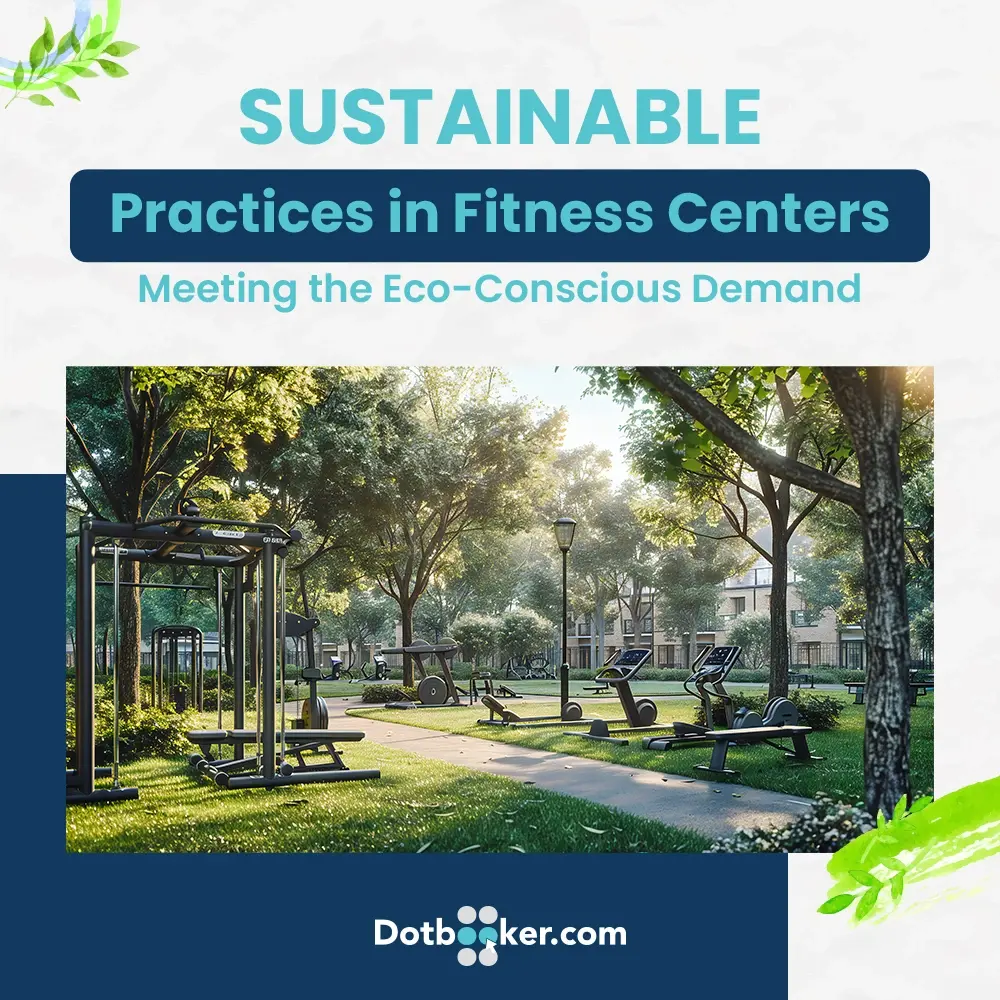
- By Dotbooker
- May 05, 2025
- 1167
Sustainable Practices in Fitness Centers: Meeting the Eco-Conscious Demand
Picture this: You're stepping into a gym—not just any gym, but one where the lights dim as natural sunlight pours in, the air smells clean without the sting of chemicals, and each drop of your sweat contributes to powering the machines you're working out on.
This isn’t a futuristic fitness utopia. It’s the new face of the fitness industry—driven by eco-conscious demand, shaped by sustainable fitness practices, and inspired by a world that no longer sees wellness and environmental impact as two separate things.
Why Eco Matters in Exercise?
Today’s fitness enthusiasts aren't just flexing muscles—they’re flexing values. They're questioning every detail, from choosing plant-based protein powders to shopping for ethically sourced activewear. And if your gym still runs on plastic cups and paper waivers, let’s just say it won’t cut this new generation of mindful movers.
The message is loud and clear: Environmental responsibility in fitness isn’t optional anymore. It’s expected. And it’s redefining how gyms operate, communicate, and grow.

Reimagining the Workout Space
What if a gym wasn’t just where you burn calories, but also where your environmental values got a workout?
Reimagining the modern fitness space means breaking free from the industrial-era gym design—harsh fluorescent lights, endless plastic, and energy-guzzling machines—and stepping into an environment prioritizing personal health and planetary well-being.
Here’s what a sustainably reimagined gym might include:
Energy-Regenerating Equipment
Machines like the ECO-POWR™ line from SportsArt convert human kinetic energy into usable electricity.
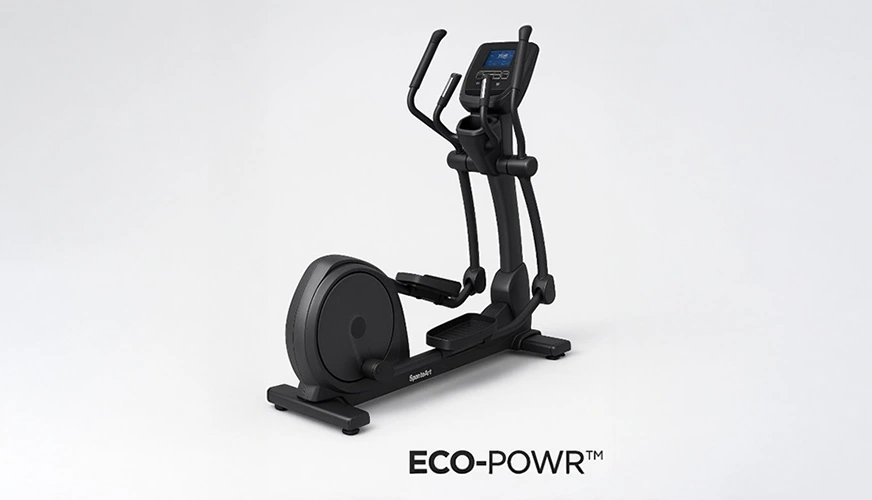
A typical 30-minute cardio session can generate up to 160 watt-hours—enough to power a laptop for over 5 hours. Multiply that by dozens of members, and you’ve got real impact.
Sustainable Flooring & Materials
Cork, bamboo, and recycled rubber aren't just for niche yoga studios anymore.

These materials are durable, cost-effective over time, and create a soft, noise-absorbing surface that benefits members and staff alike.
- Low-Impact Lighting: Natural daylighting through skylights and windows reduces reliance on artificial light. When paired with motion-sensor LED lighting, gyms reduce power use during off-peak hours—a simple tech upgrade with long-term payoff.
Green Certifications
Gyms that meet LEED (Leadership in Energy and Environmental Design) or Fitwel (a global health and wellness standard) standards gain credibility and often qualify for energy rebates or tax incentives.
Below are two examples of fitness centers that have green certification:
1. 300 West Sixth – Austin, TX
This facility has earned Fitwel certification, highlighting its focus on health and wellness in building design. (Fitwel)
2. Marriott International’s Headquarters
Marriott International’s headquarters has received Fitwel certification, emphasizing its dedication to creating a healthy work environment.
Digital-First Design
Digital screens, paperless kiosks, and app-based check-ins eliminate the need for flyers, forms, or printouts. Bonus: It feels modern, and it saves trees.
Green design doesn’t have to feel rustic or low-budget—it can feel elevated, intentional, and premium. A thoughtfully reimagined space becomes more than a gym—it becomes a destination.
The Rise of Green Fitness Initiatives
The global shift toward eco-awareness isn’t slowing down—it’s sprinting ahead, and gyms that lead with action rather than slogans are earning devoted followings.
Let’s look at real-world examples of green fitness initiatives making waves:
- Terra Hale, London: This eco-conscious boutique gym uses human-powered bikes and reclaimed décor and even offers eco-challenges to incentivize members to reduce their environmental footprints. The result? A 70% member retention rate and growing press coverage.
- The Green Microgym, USA: With a mission to “make fitness sustainable,” this gym boasts over 50,000 kilowatt-hours of electricity that members generate. It also runs a bike-to-gym challenge, cutting members' CO2 footprints while boosting community engagement.
- California’s Green Gym Program: In partnership with local municipalities, this pilot program encourages public fitness centers to retrofit their facilities using solar power, energy-efficient systems, and zero-waste protocols, supported by state grants.
- Digital Detox + Nature Bootcamps: Some gyms, especially outdoor-focused ones, now host “Eco Bootcamps” that combine fitness with park cleanups, trail restoration, and mindfulness sessions. It's fitness with purpose, and people love it.
Why do these initiatives matter? Because they signal that your gym isn’t just a business—it’s a partner in the fight for a better planet. That emotional resonance builds trust, loyalty, and yes, word-of-mouth marketing.
What Gym Owners Need to Know?
Sustainability isn’t just about installing solar panels or banning straws—it’s about a mindset shift that touches every corner of your business.
Here’s what savvy gym owners are prioritizing in 2025:
1. Understand the Eco-Conscious Customer
Your customers—especially Millennials and Gen Z—are willing to pay a premium for sustainable services. 75% of Gen Z consumers say sustainability is more important than brand name. If your gym isn’t aligned with their values, they’ll go elsewhere.
2. Think Lifecycle, Not Just Usage
Every item in your gym has a footprint—from the yoga mat to the vending machine. Switch to brands that offer closed-loop manufacturing, recycled materials, or take-back programs.
3. Train Your Staff
Sustainable practices fail when only management cares. Your team should be trained on everything from sorting waste properly to using eco-cleaners, speaking to members about your green mission, and reducing utility overuse.
4. Measure and Market Your Impact
What gets measured gets improved. Start small—track your monthly water and power use, and set reduction goals. Then communicate this journey with your audience through newsletters, wall posters, or an in-app dashboard.
5. Partner with Sustainable Brands
Whether it’s your protein supplier or apparel vendor, align with partners who follow ethical and eco-friendly practices. These collaborations build your green credibility and expand your reach.
Bottom line? This isn’t just “good PR.” It’s future-proofing your gym for an economy that increasingly rewards responsibility and transparency.
Going Green Doesn’t Mean Going Broke
Let’s bust this myth once and for all: sustainability is not an expense—it’s an investment with financial and brand returns.
Yes, the initial cost of retrofitting or upgrading can seem steep, but the payback period is shorter than you think:
- LED Lighting can reduce electricity bills by 30–50%. Over three years, that’s thousands saved.
- Water-Saving Fixtures (like low-flow showers and auto-off faucets) not only lower bills but also protect against overuse fines in drought-prone areas.
- Cloud-based management platforms eliminate the need for on-site servers, paperwork, and hardware, freeing space and reducing IT costs.
- Government Incentives: Many countries offer tax breaks or funding programs for small businesses that go green. Check with local bodies or environmental NGOs—you might be surprised what you qualify for.
And don’t forget the less-tangible benefits:
- Improved brand image
- Higher retention
- Premium pricing potential
- Member satisfaction and referrals
So instead of asking “Can we afford to go green?” ask “Can we afford not to?”

Making Eco-Friendly Gyms the Norm, Not the Niche
We’re not talking about a passing trend anymore. Sustainability in fitness is quickly becoming the default expectation, not the quirky exception.
The next time someone shops for a gym membership, they’re not just scanning for squat racks or Zumba classes—they’re scanning for alignment with their identity. And if your facility doesn’t reflect that, they’ll move on.
So, how do we take eco-fitness from niche to norm?
- Education as Part of Culture: Host sustainability workshops, share impact stats monthly, and involve members in green decisions. This transforms passive users into active advocates.
- Integrate, Don’t Isolate: Your eco-practices shouldn’t be confined to a “green corner.” They should be part of every process—cleaning, training, scheduling, supply chain, and communication.
- Community-Based Challenges: Run zero-waste months, “green commute” leaderboards, or group charity workouts that benefit environmental causes. These not only build loyalty but create buzz.
- Lead by Example: Owners and trainers should embody the change. Show your reusable bottle, share your biking story, or highlight your green vendors. People are inspired by authentic leadership.
- Celebrate Progress, Not Perfection: You don’t need to be 100% carbon neutral overnight. What matters is the willingness to evolve. Share the story—your wins, your stumbles, your vision.
When more gyms start thinking this way, eco-friendliness will no longer be an add-on—it will be the standard.
Nature Is the New Gym: The Rise of Open-Air and Jungle Fitness Centers
Who says fitness needs four walls and a neon sign?
Around the world, a new wave of gyms is ditching the traditional brick-and-mortar model in favor of something far more organic—training spaces rooted in nature.
Whether it’s deep in the jungle, by the ocean, or up in the mountains, these gyms are showing that environmental wellness and physical fitness can literally go hand in hand.
Let’s look at some standout examples reshaping what a gym can be:
Jungle Gym – Tulum, Mexico
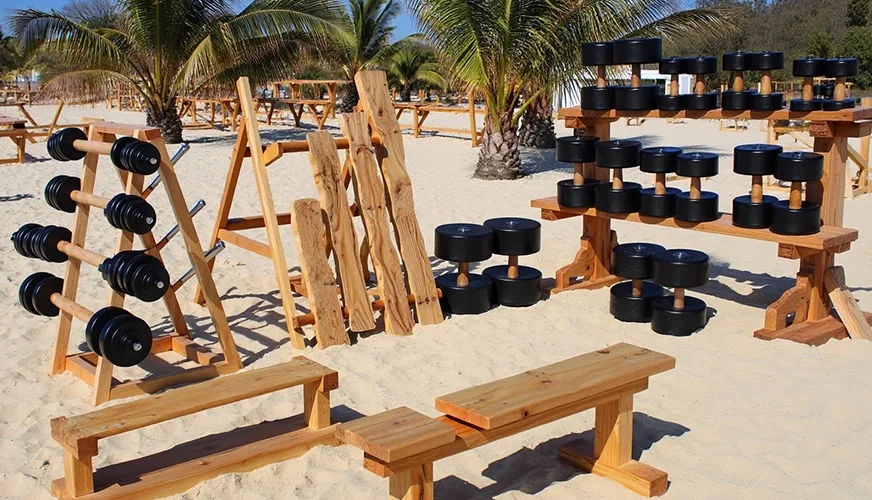
Built with bamboo, wood, and stone, this beachside gym offers members a natural and raw workout experience.
It’s not just about fitness—it’s about embracing simplicity, sustainability, and the sun. No AC, no electricity—just bodyweight, ocean breeze, and grit.
Muscle Beach – Miami, Florida, USA

A world-famous open-air gym right on the sand, it's more than just a fitness landmark; it's a cultural hub that celebrates outdoor training and body positivity.
Why it thrives: Miami’s climate supports year-round open-air workouts, and its beach-centric culture naturally attracts locals and tourists to train outdoors.
Atlanta BeltLine Fitness Parks – Georgia, USA
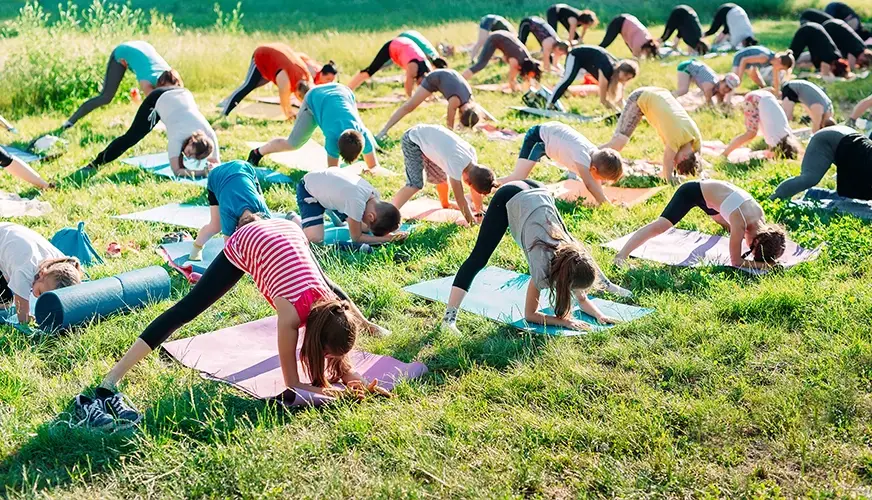
An innovative city project turned green fitness destination, the BeltLine features open-air gyms, running trails, and workout stations in repurposed railway corridors.
Why it works: It blends urban sustainability with community wellness, revitalizing unused space into a place where nature and fitness coexist.
Bali Training Centre – Indonesia

This tropical paradise gym, with an open-air setup, caters to digital nomads and wellness travelers. Its eco-friendly design reduces energy use and amplifies the connection between body, mind, and the surrounding jungle.
Jungle Bay Fitness Studio – Dominica, Caribbean
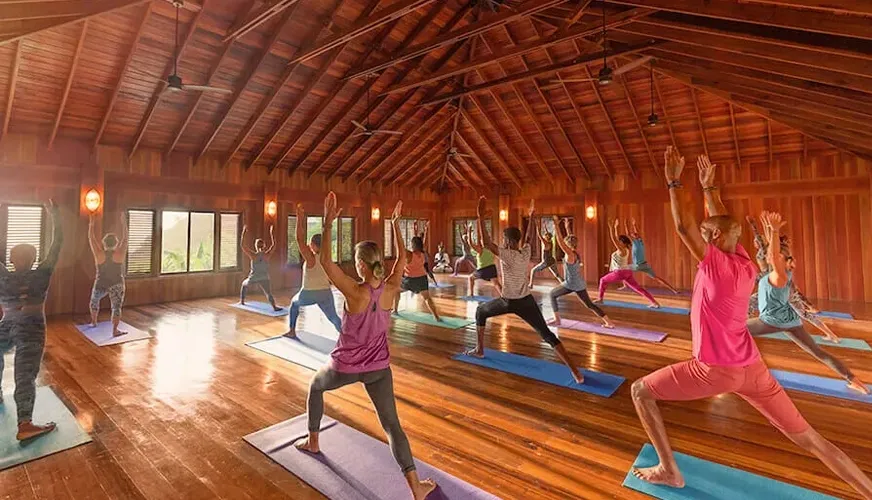
A fitness studio nestled in the rainforest, this facility takes eco-luxury to another level. Surrounded by flora, fauna, and ocean views, it offers a full-body workout and a mental reset.
Bondi Outdoor Gym – Australia
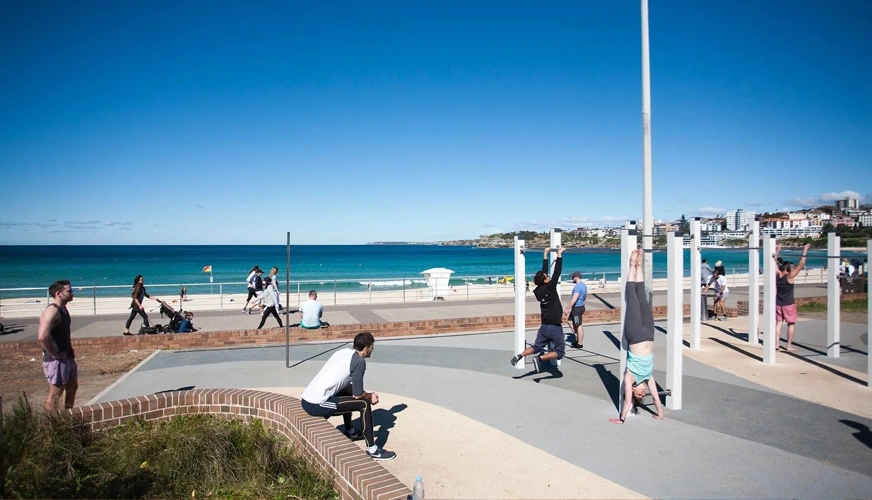
Overlooking Sydney’s famous Bondi Beach, this public outdoor gym has become a wellness landmark. Free-to-use equipment and ocean views create a fitness experience that’s inclusive, energizing, and irresistibly Instagrammable.
Why Are Gyms Going Wild?
The shift isn’t just about aesthetics—it’s strategic:
- Eco-alignment: These setups rely on natural light, ventilation, and local materials, slashing energy consumption and carbon output.
- Emotional connection: Nature boosts endorphins. Exercising outdoors enhances mood, focus, and motivation.
- Wellness tourism: More travelers are seeking detox retreats, eco-bootcamps, and spiritual escapes, with movement built in.
- Market differentiation: Being different is powerful in a saturated market. These gyms stand out because they are outside the norm.
From jungle vines to beach benches, these gyms aren’t just changing scenery—they’re changing the script on what fitness can mean in an eco-conscious era.
A Stronger, Greener Tomorrow Starts Here
The fitness industry is evolving, leaving behind those who cling to outdated systems and wasteful operations. But for those willing to embrace the wave of sustainable fitness practices, the rewards are massive: deeper member trust, reduced costs, and a brand that resonates in a fast-changing world.
At Dotbooker, sustainability should be built into your business's foundation. That’s why our all-in-one platform eliminates paper forms, centralizes digital bookings, supports cloud-based data storage, and empowers you to run a leaner, greener operation.
So, whether you're just planting the seeds of change or already sprinting down the eco-track, know this:
Fitness is no longer just about strength. It’s about stewardship.
Let your business be both strong and sustainable.
Popular Blogs

- Oct 20, 2022
- 4744

- Sep 08, 2024
- 4069

- Nov 11, 2022
- 3509

- Sep 16, 2024
- 2886
Transform your business now!

Get an expert consultation for your business's streamlined operations.